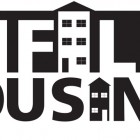Conversations
Clothes lines in St.Albert, Are they and should they be legal?: Drawing the (Clothes) Line - When should municipalities step in?
BY DEBRA CLARK
December, 2015
| Two poles and a piece of rope sound harmless enough to most people, but clotheslines continue to provoke debate in communities across the country. The humble structure, sometimes banned, has found itself at the centre of neighbourhood battle lines in a clash of ideas about the environment, individual rights, class and nostalgia. |
In Canada, municipalities, condominium corporations and sometimes even developers and builders have restricted people from hanging their sheets and unmentionables outside to dry in the breeze. However, rules, imaginary or otherwise, seemingly detract from the efforts of devoted environmentalists as clotheslines continue to be a scarce sight in most modern-day backyards.
Municipal Bylaws
In St. Albert, homeowners are free to let it all hang out on their laundry lines, as there is no municipal ban preventing the use of clotheslines. Carol Bergum, Director of Planning and Development for the City of St. Albert, says while not explicitly named in the Land Use Bylaw (LUB), clotheslines would be classified as an accessory building should a complaint be received. “It’s not specifically laid out, but there would be certain height requirements in addition to the location,” Bergum says. “A building is defined as anything constructed or placed on, in, over or under land,” she adds. According to the LUB, an accessory building must not be located in a front yard or be more than 3.7 metres above finished grade. It must be located a minimum of one metre from side and rear property lines in the backyard and may be located in a screened side yard under certain circumstances. “We do not require development permits for clotheslines and are not obligated to enforce complaints about them. However, if we get a concern about a clothesline, as a courtesy, we would then review that using this section as basis for enforcement if something really isn’t appropriate—like a clothesline coming from the second floor of a house, for example,” Bergum explains. “We seldom receive clothesline complaints—maybe once a year, if that.”
Aaron Giesbrecht, Manager of Policing Services with the City of St. Albert, says while he can’t recall receiving a clothesline complaint in his 15 years on the job, it is possible to pursue under the ‘land’ or ‘building’ sections of the Community Standards Bylaw in extreme cases. “Essentially what officers deal with here are complaints about property being unkept and unsightly,” Giesbrecht says. “There’s nothing in there [bylaw] that talks about clotheslines, so it wouldn’t be enforced unless it became a situation that was unsafe and one where someone might get hurt. If somebody calls in just to say their neighbour has a clothesline and they’re putting their clothes up to dry, our officers aren’t even going to take the complaint,” he adds.
While the City of St. Albert doesn’t seem too hung up over clothesline use, in July, 2014 Mississauga, Ontario became one of the few Canadian cities to pass a bylaw specifically addressing the use of outdoor clotheslines. Homeowners in the country’s sixth largest city are restricted to one clothesline per home, unless they have a second licensed unit (like a basement apartment), in which case there can be two. Clotheslines must be in the backyard and in a straight line, no higher than three metres from ground level and must be set back 1.25 metres from the property line. The Ontario Green Energy Act prevents municipalities in Ontario from banning clotheslines outright, but they can pass bylaws regulating their use. Montréal also has a clothesline bylaw, albeit less complex, allowing the structure only in backyards. Meanwhile, an official from the Montréal suburb of Hamstead, Québec confirms a bylaw currently exists that prohibits their use altogether.
The Wind of Opposing Views
An extreme case and a seemingly ugly dispute between neighbours may have prompted a strict Mississauga bylaw, but at the heart of the issue for many who oppose the outdated practice is that clotheslines are unattractive and a marker of poverty that, in turn, decreases the value of a neighbourhood. David Suzuki’s Queen of Green, Lindsay Coulter, says people who oppose certain things tend to have a louder voice. “For a lot of people it’s an aesthetic thing. It maybe doesn’t look as pretty on the building or in the backyard, which is sort of silly when you think of the big picture and how it could be reducing energy use,” she says. Personal trainer and health coach in the Greater Toronto area, Gary Drisdelle, set up International Clothesline Week (held annually the first week in June) 10 years ago as a way to think about alternate sources of energy. “Aesthetics and property values seem to be the main obstacle to the use of clotheslines, but many of these bylaws have been challenged and won in court,” he says. According to Drisdelle, over 80 percent of households have a clothes dryer, so if every household let more clothes drip dry it would not only translate into energy and dollar savings but also less pollutants into the air.
Coulter says while the David Suzuki Foundation doesn’t have a laundry campaign per se, it definitely favours energy efficiency. “There are many reasons you should dry your clothes this way versus putting them in a dryer,” she points out. “It’s just easier on your clothes. The heat from dryers is hard on all your fabrics—so your clothes just don’t last as long. What you’re also not taking advantage of is the sun’s natural bleaching and antibacterial properties,” Coulter explains. “Part of what I do is to get people to believe in the small steps and get them unstuck from the notion that they are just one person, [so] what can they do.” As an example of empowerment, Coulter points to her work with a St. Albert couple to get a toilet rebate program going. In addition to the program being implemented in 2012, it was approved again by council on December 15, 2014, for rollout this spring.
The Facts
According to ATCO EnergySense, dryers account for about 12 percent of the electrical consumption in a typical Alberta home. Assuming $0.11 per kilowatt hours (kWh), electric dryers use 77 kWh of energy per month, which adds up to around $8.47. Both Natural Resources Canada and ATCO confirm that over the past 20 years, the efficiency of clothes dryers has improved only about 17 percent, leaving dryers as one of the largest consumers of energy in the home. A recent ATCO publication, Managing Electricity at Home, points to the reduction in electricity consumption as one of the easiest ways people can lower the amount of energy used in homes. The average house in Alberta uses roughly 600 kWh of electricity each month.
A published report in 2014 points to an Air Quality Ontario finding that a clothes dryer using 900 kWh hours of electricity each year results in up to 840 kilograms of air pollution—or roughly the equivalent of burning 365 litres of gasoline.
Jason Maloney with Alberta Environment and Sustainable Resource Development says any reduction in electricity usage will impact emission levels, but actual numbers would depend on a host of factors such as the number of people and the amount of laundry. “Alberta is working on a new climate change framework. As part of developing the framework, energy efficiency is being looked at. No decisions have been made as to what any future energy efficiency programming may look like.”
Condos and Covenants
Regulations in many condominiums and apartment buildings make hanging clotheslines an illicit activity. Brian Fischer, President of KDM Management in St. Albert, says it’s fairly common for clotheslines to be restricted via the condo corporation’s bylaws. “While each condo corporation has its own set of bylaws, I would say that it is safe to assume that 90-plus percent would restrict clotheslines. In fact, it is typically a very specific and standard bylaw that states something along the lines of ‘no laundry will be hung outside of the unit,’” Fischer says. The intent, he explains, is to maintain the aesthetic integrity of the condominium complex. “While people should be able to conserve energy if and when possible, they must appreciate that condominium living is communal living. The bylaws help provide structure and are intended to have the best needs of all owners in mind,” he adds. “Owners can stand for election to their board of directors at their annual general meetings to get more involved. Bylaws can be changed if enough owners are in agreement.” Fischer cautions that with all real estate, it is buyer beware. “When buying a condominium, you should always make the review of the condominium documents a condition of your offer and take the time to examine it. There is a lot of important information, not just limited to the bylaws.”
It is possible that covenants in subdivision agreements can also prohibit the use of clotheslines. In 2008 a Sherwood Park couple made news by signing a lengthy restrictive covenant that prevented, among other things, clotheslines. Garry Wetsch, counsel to Landrex in St. Albert, says clotheslines are not an issue he has ever come across and are not included in any of his agreements. “As a developer we try to limit our restrictive covenant to very basic guidelines to reflect the type of neighbourhood we want. The more restrictions we put on the worse it gets, because covenants are not flexible and are hard to change.” says Wetsch. “They [covenants] shouldn’t affect the use and enjoyment of somebody’s house and lot—the purpose of them is to protect certain things we [City and Landrex] believe should survive, such as fencing, boundary walls and various architectural controls,” he explains. “You have to have a balance of not making it so restrictive that it causes subsequent owners grief.”
In 2010 the province of Nova Scotia passed An Act to Prevent Prohibitions on the Use of Clotheslines to ensure no bylaw or covenant would prevent or unreasonably restrict the use of a clothesline outdoors at a single-family home or on the ground floor of a multi-residential building. Ontario regulation, passed in 2008, overrides the restrictions that some developers impose on neighbourhoods (homes with backyards) they build. According to Alberta Environment and Sustainable Resource Development, there is no such similar Alberta legislation in place or planned at this time.
Drawing the Line
City of St. Albert Mayor Nolan Crouse says while the clothesline issue hasn’t come to his attention in 11 years on council, municipal bylaws help with a civil society. “Their [bylaws] purpose is to have governance processes in place that outlast the decision makers. They protect willy-nilly changes at someone’s whim because it requires a process to change them,” explains Crouse.
While City Councillor Tim Osborne is personally in favour of clotheslines, he assumes that the majority of people use them in a respectful and responsible manner. “I don’t think the City needs to micromanage everything and not everything needs to be covered by law. By and large, people make good choices,” he says. Councillor Cam MacKay agrees that while bylaws are there to protect the personal property and safety of the individuals living within the municipality, there is a limit. “As we get more and more laws, I sometimes wonder how large the set of regulations needs to be to govern a body of people. Not just at the municipal level, but provincial and federal,” MacKay says. “I think we [council] have to be careful because there are already so many things on the books. In practical application, unless a bylaw is supported by 95 percent of the population, it becomes too costly to enforce and therefore loses any affect it might have,” he explains.
“There are privileges to living in a city, and you need to give some concessions. If you don’t like the look of a clothesline for example, your neighbour might. Unless it’s personally hurting you, I don’t believe it should be regulated,” Councillor Cathy Heron points out. “I think what St. Albert needs to do is take a stance that’s a little broader than clotheslines. It’s about living green. You would never want to regulate it, but you can encourage it,” she says. “Sustainability is required in our future. We can’t continue to build, waste and sprawl across the land like we are today. We need to be more sustainable as a city and a culture—and it takes a council that is ready for that,” she argues. “We [council] haven’t been very bold yet. We need to take a leadership role when it comes to certain things—for example with escalating water rates maybe we should have a lower rate for people who make an effort to conserve and a higher rate for abusers.”
As part of a limited review of the LUB set to take place in 2015, [Carol] Bergum’s group with the City will be looking at sustainability components such as solar panels, an issue that has become more prevalent with both residents and builders in recent years. “I put this forward because I think it’s time we looked at it as something that could be incorporated into a development,” says Councillor MacKay. “It’s a question of how we permit it—for example can it be your entire roof, does it need to be a certain distance from the property line?” he says. “The benefit of having solar panels as part of a bylaw is then you can say it’s covered and there is no grey area,” he adds.
“We only want to impose bylaws where there are problems. Our role should be limited to protecting people, but not necessarily telling them what they should be doing every moment of their day,” says Councillor Sheena Hughes. “The line has to be drawn when you start looking at where the potential of what your actions are will have an impact, or seriously could have an impact, on the quality of life of your neighbours, and whether or not what’s being done is going to affect the potential safety of your property and surrounding community.” t8n
To learn more about City’s environmental projects, programs and policies visit: stalbert.ca/city-services/environment/
Clotheslines In the Cold
Laundry may be dried outdoors when the temperature is well below the freezing point. First the moisture in the laundry freezes (leaving the clothing stiff) and then the frost on the clothes sublimates into the air leaving the items dry. It’s usually much quicker to dry them indoors; however, indoor drying removes heat from the air so it is a trade-off between speed and energy efficiency.













